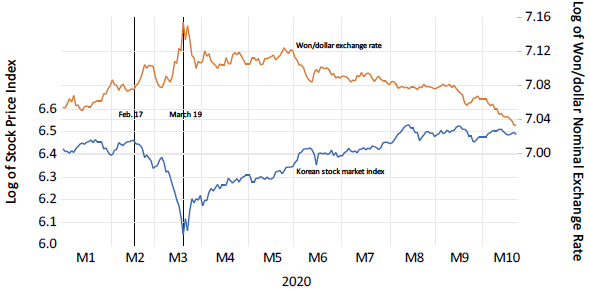| Author Name | Willem THORBECKE (Senior Fellow, RIETI) |
|---|---|
| Download / Links |
This Non Technical Summary does not constitute part of the above-captioned Discussion Paper but has been prepared for the purpose of providing a bold outline of the paper, based on findings from the analysis for the paper and focusing primarily on their implications for policy. For details of the analysis, read the captioned Discussion Paper. Views expressed in this Non Technical Summary are solely those of the individual author(s), and do not necessarily represent the views of the Research Institute of Economy, Trade and Industry (RIETI).
After the COVID-19 pandemic hit the world economy, Korea suffered capital outflows. As Figure 1 shows, between 17 February and 19 March 2020 the won depreciated by 8 percent and the Korean stock market fell by 42 percent. Both the won and the stock market increased markedly beginning on 19 March. This was the day when the Bank of Korea (BOK) and the Federal Reserve agreed to a 60 billion U.S. dollar swap arrangement. This agreement reassured investors that dollar liquidity would be available in the Korean economy.
Korea slowed the spread of the virus without strict lockdowns. The government employed extensive testing and used artificial intelligence and advanced technologies to trace the contacts of infected individuals. It quarantined and tested these contacts. Private developers also fashioned an app called Corona 100m that employs government data and notifies users of infected individuals within 100 meters, along with their nationalities, ages, and gender. It was downloaded over a million times within a few weeks.
The government also implemented four supplementary budgets. These provided support for businesses and households, funds for controlling the virus, and aid to local governments. The Bank of Korea lowered the Base Rate from 1.25 percent to 0.5 percent and used open market operations and lending support to provide funds to banks, non-bank financial institutions, and small and medium-sized enterprises.
This paper investigates how individual sectors of the Korean economy have fared during the pandemic. To do this it traces the response of Korean stock prices in 59 sectors from 17 February to 4 December 2020. Black (1987, p. 113) noted that, "The sector-by-sector behavior of stocks is useful in predicting sector-by-sector changes in output, profits, or investment. When stocks in a given sector go up, more often than not that sector will show a rise in sales, earnings, and outlays for plant and equipment." Stock prices thus summarize the forecasts of many investors on the prospects for individual sectors. The paper also divides returns into the portion explained by macroeconomic factors and the portion driven by idiosyncratic influences. This can shed light on whether sectors are being affected by changes in the macroeconomic environment in Korea and the world or by sector-specific characteristics during the pandemic.
The worst performing sectors over the 17 February to 4 December 2020 period include food retail & wholesale, electricity, casinos & gambling, travel & leisure, cosmetics, and marine transport. The values on 4 December of 1 won invested on 17 February was 0.748 won for food retail & wholesale, 0.811 won for electricity, 0.817 won for casinos & gambling, 0.830 won for travel & leisure, 0.871 won for cosmetics, and 0.875 won for marine transport. These losses were driven entirely by sector-specific responses during the pandemic and not by changes in the macroeconomic environment. The wholesale & retail trade sector is composed primarily of convenience stores. During the pandemic visits to these stores have tumbled. The entire tourism sector, including casinos & gambling and travel & leisure, has also suffered. As people have left their house less, the demand for cosmetics such as lipstick has fallen. Also with a reduction in world trade, the marine transport (shipbuilding) sector has suffered.
The best performing sectors include industrial machinery, chemicals, health care, biotechnology, consumer digital services, pharmaceuticals, automobiles, software & computer services, leisure goods, electronic entertainment, consumer electronics, electronic components, and household furnishings. The values on 4 December of 1 won invested on 17 February were 2.11 won for industrial machinery, 1.71 won for chemicals, 1.68 won for healthcare, 1.67 won for biotechnology, 1.66 won for consumer digital services, 1.42 won for pharmaceuticals, 1.37 won for automobiles and for software & computer services, 1.29 won for leisure goods, 1.26 won for electronic entertainment and for consumer electronics, 1.25 won for electronic components, and 1.21 won for household furnishings. These gains were driven both by macroeconomic and by sector-specific factors. As the Korean and world macroeconomic outlooks have improved, the prospects for Korean manufactured goods such as industrial machinery, automobiles, consumer electronics, and electronic components have improved. Chemical companies such as LG Chem have benefited from the demand for lithium ion batteries. Healthcare, biotechnology, and pharmaceuticals have also gained from increased demand during the pandemic. Finally, sectors such as consumer digital services, software & computer services, leisure goods, electronic entertainment, and household furnishings have benefited from increased demand by consumers hunkered down at home.
The important implication of these results is that many sectors such as convenience stores and tourism that employ lower paid service workers have suffered during the pandemic. On the other hand, firms employing higher skilled workers and producing electronics, automobiles, industrial machinery, software and computer games face brighter prospects. The pandemic thus reinforcing harmful trends that existed before the crisis. For instance, the manufacturing sector is doing better than the service sector. In addition to providing relief to suffering service sector workers, the government should consider using the crisis to push through reforms such as easing product market regulations that could reduce longer-term structural inequities between manufacturing workers and service workers and between conglomerates and SMEs.

- Reference(s)
-
- Black, F. (1987). Business Cycles and Equilibrium, Basil Blackwell, New York.

